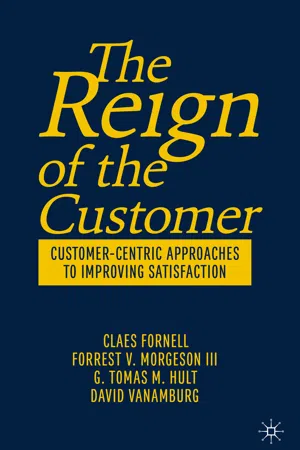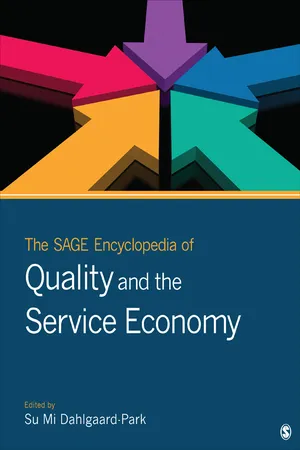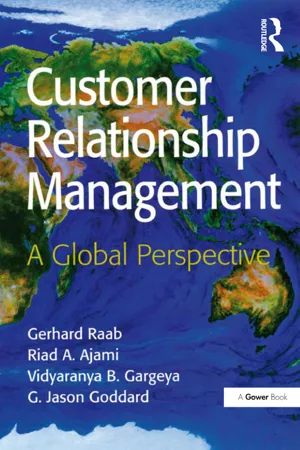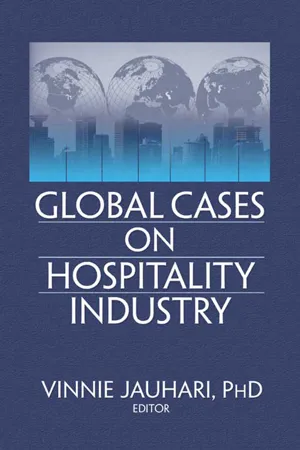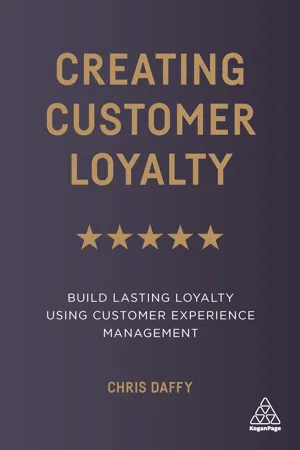Customer Expectations
Customer expectations refer to the anticipated level of service, quality, and experience that customers believe they should receive from a business. These expectations are shaped by past experiences, marketing messages, and industry standards. Meeting or exceeding customer expectations is crucial for customer satisfaction and loyalty, and businesses often use customer feedback to understand and manage these expectations.
8 Key excerpts on "Customer Expectations"
- Philip Berners, Adrian Martin(Authors)
- 2022(Publication Date)
- Routledge(Publisher)
...This is because Customer Expectations can vary from one customer to another from the same marketing message. This is the challenge and should be relished because that is the job of providing good customer service. Challenges present learning opportunities for self-development and professional development. Experience of challenges such as these is valuable for future situations which is why employers look for candidates with experience in customer service. Remember, all experiences arising from challenges are good for the curriculum vitae. There is a saying that we can only please 95% of customers 95% of the time as a measure of success, rather than 100%. But should The Manager tolerate such a failure rate? Is this level of unfulfilled expectations inevitable, or can it be managed? To answer these questions requires an understanding of the breadth of sources of information a customer relies upon when setting their own expectations before arriving to an event or hotel: External communications – all the advertising and social media communication that has gone out will help shape the customers’ expectations. Photoshopped pictures of the best areas of the venue or hotel, for instance, can raise expectations (and sales). The social media output and overall wording of text will create a picture, realistic or otherwise, of the event the customer will experience. Brand reputation – one of the advantages of a well-respected brand is the pre-conceived expectations it brings to customers. This assists with sales but can raise customers’ expectations to unrealistic levels. Word of mouth (WOM) – customers can exaggerate to an unrealistic level which transfers to become other customers’ expectations...
- eBook - ePub
The Reign of the Customer
Customer-Centric Approaches to Improving Satisfaction
- Claes Fornell, Forrest V. Morgeson III, G. Tomas M. Hult, David VanAmburg(Authors)
- 2020(Publication Date)
- Palgrave Macmillan(Publisher)
...Certainly, Customer Expectations may increase as perceptions of quality, value, and customer satisfaction improve and consumers adjust expectations of future experiences upward. This is precisely what we have seen over the past 25 years. In this sense, firms must continue to adequately manage expectations and set expectations they are capable of meeting. However, fretting over customers with out-of-control expectations that cannot be met is a waste of time and resources for firms and ultimately allows firms to explain-away deficiencies in the products and services they offer consumers that are hurting their growth relative to competitors. References and Further Reading Anderson, E. W., & Sullivan, M. W. (1993). The Antecedents and Consequences of Customer Satisfaction for Firms. Marketing Science, 12 (2), 125–143. Cadotte, E. R., Woodruff, R. B., & Jenkins, R. L. (1987). Expectations and Norms in Models of Consumer Satisfaction. Journal of Marketing Research, 24 (Aug.), 305–314. Corporate America under Pressure from Consumers’ Rising Expectations. (2015, June 2). Lithium. Retrieved from https://www.lithium.com/company/news-room/press-releases/2015/corporate-america-under-pressure-from-consumers-rising-expectations Fornell, C., Johnson, M. D., Anderson, E. W., Cha, J., & Bryant, B. E. (1996). The American Customer Satisfaction Index: Nature, Purpose and Findings. Journal of Marketing, 60 (4), 7–18. Hayken, S. (2016, November 12). Today’s Customers Demand Customer Service on Their Terms. Forbes.com. Retrieved from https://www.forbes.com/sites/shephyken/2016/11/12/todays-customers-demand-customer-service-on-their-terms/#3fa535cdcaa2 Hult, G. T. M., Morgeson, F. V., III, Morgan, N. A., Mithas, S., & Fornell, C. (2017). Do Managers Know What Their Customers Think and Why? Journal of the Academy of Marketing Science, 45 (1), 37–54. Markovitch, S., & Willmott, P. (2014). Accelerating the Digitization of Business Processes. McKinsey Group...
- Su Mi Dahlgaard-Park(Author)
- 2015(Publication Date)
- SAGE Publications, Inc(Publisher)
...Customer Expectations Customer Expectations 110 113 Customer Expectations Customer Expectations is a very complex concept and has often been thesubject of various theoretical discussions as well as empiricalverifications. An unambiguous and generally accepted conceptual definitionof expectations does not exist. Therefore, this entry summarizes the maintypes of Customer Expectations found in the literature, presents thedominant model of customer satisfaction, and discusses empirical studies’findings on the impact of Customer Expectations on customersatisfaction. Hierarchy of Expectations A review of the service quality and customer satisfaction literatureunveils an ambiguous array of definitions of Customer Expectations,which can be boiled down to five types that reflect a hierarchy ofexpectations, from the highest level to the lowest level: The ideal expectation is what the customer wants in an idealsense (i.e., the “wished-for” level of quality), and it reflectsa perfect, excellent standard that forms the highestexpectation. The should expectation is a normative expectation congenial to“what ought to happen.” It is the result of little or no actualexperience or information. The will expectation—or predictive expectation—is the level ofquality that is predicted by the customer on the basis of allknown information (i.e., the level of quality that will, or islikely to, happen)...
- eBook - ePub
Customer Relationship Management
A Global Perspective
- Gerhard Raab, Riad A. Ajami, G. Jason Goddard(Authors)
- 2016(Publication Date)
- Routledge(Publisher)
...Thus, the customer is pleased to the highest extent with the product or with the services accompanying the product. This phenomenon is none more apparent than in the personal computer industry. In this business, every innovation results in Customer Expectations being raised. While not long ago customers were satisfied with simple functions and application possibilities, today a very impressively outfitted computer is standard equipment. It is becoming apparent here that customer satisfaction is not a goal that is attainable once and for all. Instead it is a continuously developing, dynamic target. Maintenance of the level of standards: stable customer satisfaction If perceptions more or less positively correspond with expectations, then one can speak of stabilized customer satisfaction. The customer is satisfied and constantly maintains their level of standards. Marketing research however, is unanimous in finding that the exact fulfillment of expectations is neither simple, nor reflective of the optimal state of affairs. This kind of customer satisfaction is effective from a short-term perspective, but in the long term it threatens the loss of customers. If a competitor reacts first to raised customer needs and wishes, and loss of market share to the competition ensues, then clearly the firm should have erected barriers to change earlier, which could have hindered or made impossible a customer’s turning to a competitor’s product. But this does not take into account the appropriate long-term strategy for a customer-centric company...
- eBook - ePub
- Timothy L. G. Lockyer(Author)
- 2013(Publication Date)
- Routledge(Publisher)
...21). Managers, on the other hand, may find it hard to control for them because these expectations will be different from consumer to consumer; in fact, what is good enough for one consumer may still not be acceptable for another. Although Zeithaml and Bitner (1996) have proposed a large number of determinants of desired and adequate expectations, including differences in personal needs, transitory service intensifiers, situational factors, and word-of-mouth communication, very little empirical evidence is available that supports these suggestions and that can help service managers. 1 Moreover, since quality is regarded as a degree of excellence (Zeithaml, 1988), perhaps consumers’ personal needs should not be criteria, but instead the performance level of competitors should have our focal attention when we set the comparison standard. In this chapter a different type of expectation is introduced in service-quality research: experience-based expectations. Whereas the concept of experience-based expectations has been developed in the customer-satisfaction literature (Cadotte et al., 1987), experience-based expectations are valuable in quality research as well, for at least three reasons: First, experience-based expectations are based on comparative and competitive perceived performances. As such, these expectations may be treated as the standards for quality in the marketplace (benchmark). Second, these expectations are based on multiple experiences, and they are stored in memory as category exemplars or prototypes (Sujan, 1985; Ozanne et al., 1992). Being readily available, their use requires less cognitive effort than, for example, desired or adequate expectations, which require piecemeal inference processes. Given that consumers are not always able or willing to make such inferences (Iacobucci et al., 1996), they often choose prototypical products (Nedungadi and Hutchinson, 1985; Ward and Loken, 1988)...
- eBook - ePub
Creating Customer Loyalty
Build Lasting Loyalty Using Customer Experience Management
- Chris Daffy(Author)
- 2019(Publication Date)
- Kogan Page(Publisher)
...04 Identifying, understanding and managing Customer Expectations This chapter will cover: Customer expectation management – why expectations really matter. Expectations have a great influence over customer loyalty. It is therefore important to understand why this is so and what to do about it to build loyalty. Levels and types of expectation. There are different types of expectation, each with a different impact on loyalty. What they are, and the influence they each have on loyalty, is explained in this section. Proactive expectation management. Because expectations have such a great influence over ongoing customer loyalty, it would be foolish not to manage them proactively. How this may be done effectively is outlined in this section. Preventing the problem expectations – the proven loyalty killers. There are some expectations created by employees that lead to a loss of loyalty. How these can be prevented is explained in this section. The expectation opportunity Our lives are full of expectations. They influence many of life’s decisions. If we expect something to be good, we may decide to choose it. And if we expect it will be bad, we’re more likely to decide to reject it. In the business-to-business context, many of these expectations may be managed so that customers are more likely to make the decisions we hope for. Yet most organizations don’t do this. They leave it to chance, and so miss out on this big opportunity. In this chapter I will explain what types of expectation we have as customers, and how they may be managed to enhance customer loyalty. Customer expectation management – why expectations really matter A few years ago, my wife and I were invited to attend one of the Queen’s Buckingham Palace garden parties. It was a great experience, and we will long treasure the memories of it...
- eBook - ePub
- Stephen Taylor(Author)
- 2011(Publication Date)
- CIPD - Kogan Page(Publisher)
...08 Managing expectations Introduction A major contemporary business trend that we discussed in the first chapters of this book is increased competitive intensity. For a variety of different reasons organisations in all sectors are having to compete harder with one another for both customers and effective employees. It has long been recognised that a key to ensuring that a business satisfies and retains its customers is the effective management of their expectations. The same is true of employees. In competitive labour markets, if an organisation wants to help ensure that its staff maximise their effort and their performance, and that voluntary turnover is kept to a minimum, it needs to provide its people with a satisfying experience. The effective management of expectations is central to achieving this. In this chapter we are going to focus on a number of influential perspectives on the management of people which, in their different ways, involve the management of expectations...
- eBook - ePub
- David Butler(Author)
- 2007(Publication Date)
- Routledge(Publisher)
...By this we mean what the customers expect from us as suppliers, and what the customers themselves perceive to be their needs, as opposed to what we believe them to be. What do customers expect? • From the business: pleasant and suitable surroundings which are clean, welcoming, well-lit, safe and hygienic, and living up to the general image of the business and its products or services. • From the staff: sufficient staff to be available. Staff to show a friendly, interested and welcoming attitude, and to be pleasant and non-threatening. Staff should also be smart in appearance, competent and knowledgeable. Customers also expect that dealing with the organization's staff should be a pleasant experience, and free of problems, antagonism or excuses. • From the products, goods or services: these should be available when wanted, fit for the purpose for which they were acquired, and at a reasonable price which constitutes value for money. User-friendly information should be provided as to where the product can be found, and about its use and operation. The product should also be supported by a friendly, helpful and efficient after sales service in the event of any problems arising. Why should we bother with customer service or customer care? First, let us differentiate between the two. Customer service is often described as the way in which we respond to customers and their problems. In contrast, customer care goes a stage further in that a customer care policy (like a TQM policy) tries to build a policy of awareness and responsiveness to the customer within the provision of the product or service as a whole, and with the intention of avoiding possible problems at a later stage. Customer care is about minimizing the occurrences that are likely to give rise to complaint, and responding quickly and positively when complaints do occur. The primary objectives of customer care are to: • Retain customers for repeat business. The use of sales staff and advertising etc...

